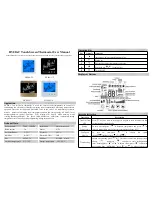
ECO GOLD
12
Device description
25/08/2011/ YACE0088
3.5
Interface modules (Accessories)
The devices can be supplemented with further interface modules which are connected to the rear of the
control head in two module slots (
Ì
6.7) and are inserted.
The following modules are currently available:
1.
Analogue Module
(LAUDA catalogue no. LRZ 912) with two inputs and two outputs on a six-
pole DIN socket. The inputs and outputs can be set independently of one another as a 4...20
mA or 0...10 V interface, 20 V is brought out on the socket as a power supply for an external
sensor with evaluation electronics.
2.
RS 232/485 Interface Module
(LAUDA catalogue no. LRZ 913) with nine-pole SUB-D socket.
Electrically isolated using optocouplers. Using the LAUDA instruction set, extensively com-
patible to the ECO, Proline, Proline Kryomat, Integral XT and Integral T series. The RS 232
interface can be connected using a 1:1 contacted cable (LAUDA catalogue no. EKS 037) di-
rectly to the PC.
3.
Contact Module
(LAUDA catalogue no. LRZ 914) with connector to NAMUR NE28. Range of
functions as for LRZ 915, but only one output and one input on each of two DIN sockets.
Coupling socket, 3-pole (LAUDA catalogue no. EQD 047) and coupling plug 3-pole (LAUDA
catalogue no. EQS 048).
4.
Contact Module
(LAUDA catalogue no. LRZ 915) on a 15-pole SUB-D socket. With three re-
lay contact outputs (changeover, max. 30V/0.2A) and three binary inputs for control via exter-
nal voltage-free contacts. Plug 15-pole, (LAUDA catalogue no. EQM 030) and Plug Housing
(LAUDA catalogue no. EQG 017).
5.
Profibus Module
(LAUDA catalogue no. LRZ 917).
You will find further information in the Operating Instructions YAAD0020 for the Profibus
Module.
6.
Pt100/LiBus Module
(LAUDA catalogue no. LRZ 918)
External Pt100
: For the connection of an external temperature sensor.
LiBus
:
For the connection of the Command remote control unit from the Proline
equipment line and other accessories, such as a solenoid valve for cooling
water control or a reverse-flow protection device.
3.6
Chiller
The chiller mainly consists of a fully hermetically sealed compressor. The dissipation of the condensation
and motor heat takes place via a fan-ventilated lamellar condenser. Here, atmospheric air is drawn in at
the front of the device, heated up and discharged at the back and sides. To ensure proper air circulation
the ventilation openings must not be covered up.
The compressor is equipped with a thermal release which responds to the compressor temperature and
current consumption. The chiller is normally switched in automatically, but can also be switched in ma-
nually via the operating menu (
Ì
The chiller is switched off when a malfunction occurs which affects safety.
The Cooling Thermostat RE 1050 G is equipped with the SmartCool technology which makes optimum
use of the compressor and only chills when cooling output is demanded by the controller. To achieve
this, several sensors in the cooling circuit monitor the operating status.
Cooling times for the various cooling thermostats can be taken from the
cooling curves
(
Ì













































